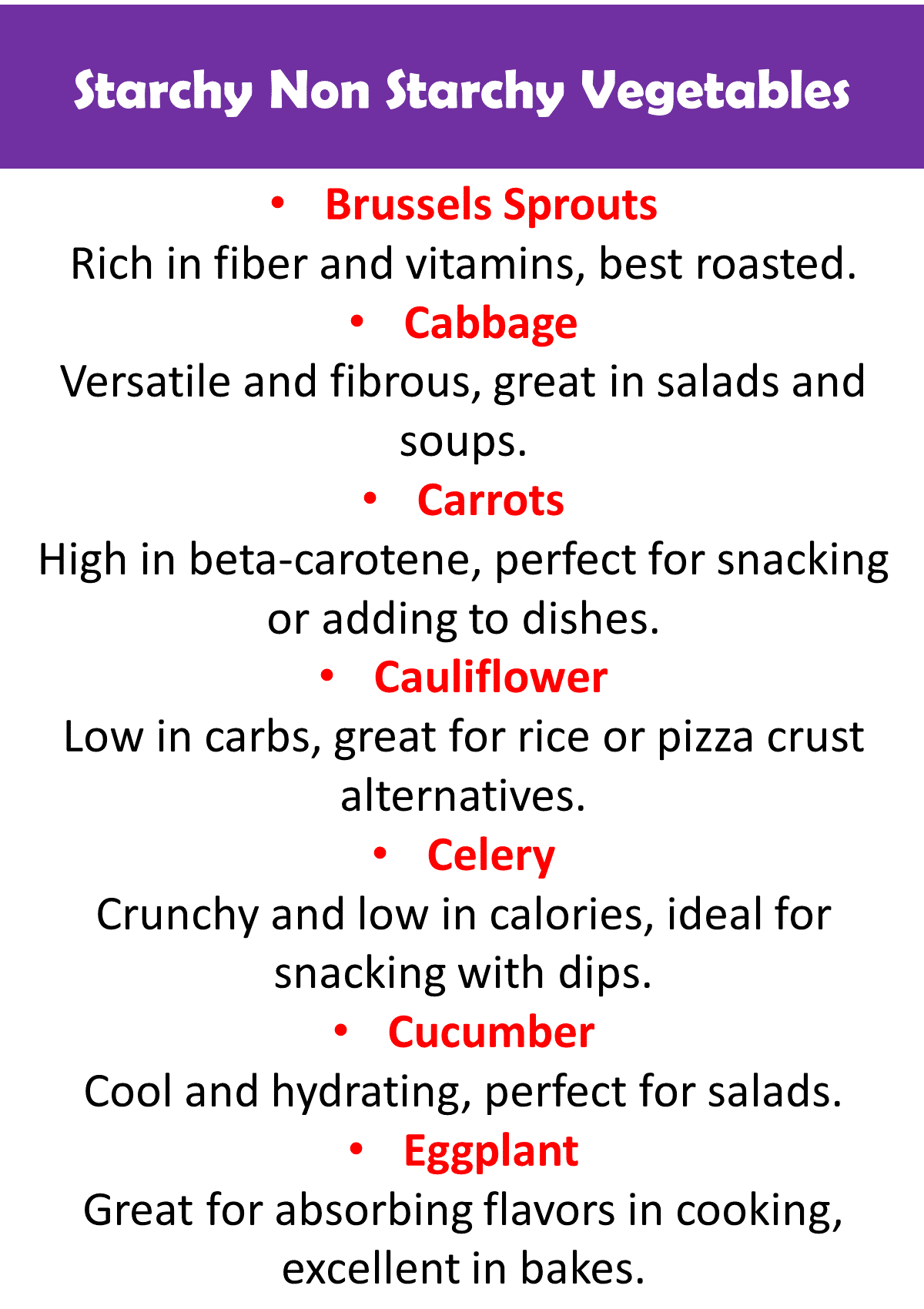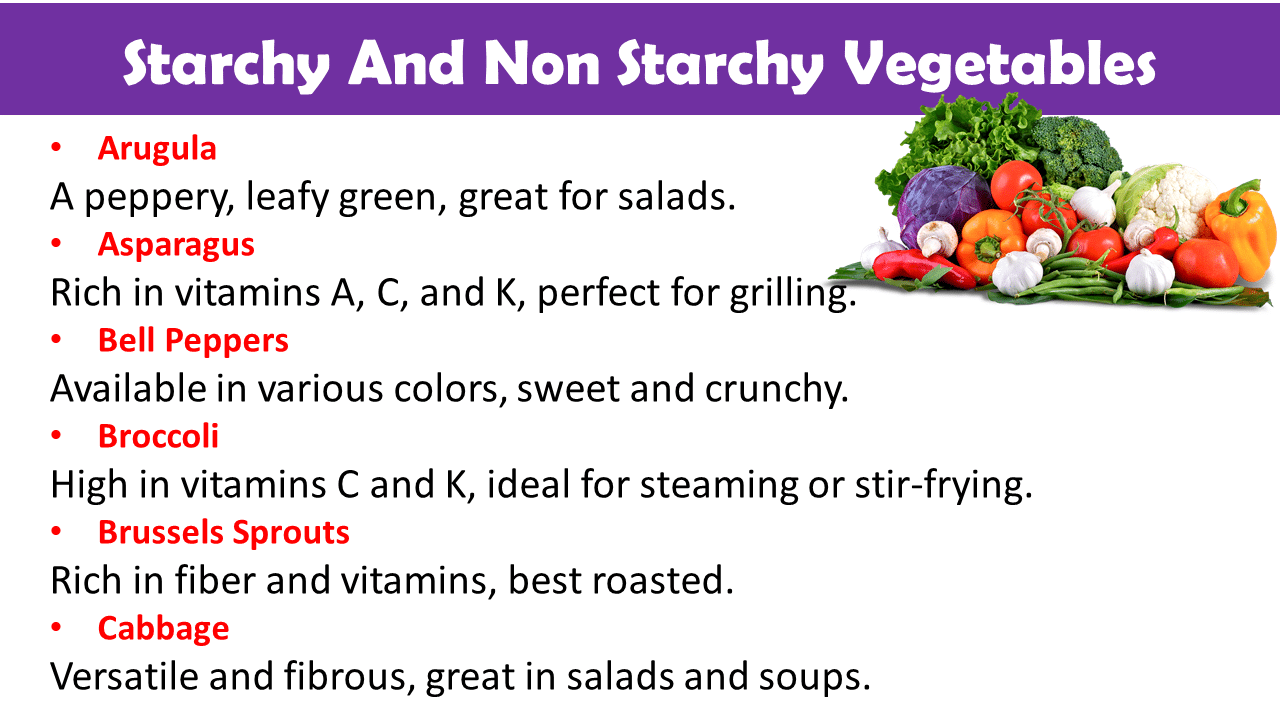Starchy vegetables are an important part of a balanced diet, providing essential nutrients and a rich source of energy. Unlike non-starchy vegetables, these vegetables contain higher amounts of carbohydrates, making them a key player in fueling the body.
Common starchy vegetables include potatoes, corn, peas, and sweet potatoes, each offering a unique blend of vitamins, minerals, and dietary fiber. While they are often more calorie-dense than their non-starchy counterparts, starchy vegetables are also packed with nutrients that support overall health. Incorporating a variety of starchy vegetables into your diet can help maintain energy levels and support a healthy lifestyle.
Starchy Vegetables
Potatoes
A versatile root vegetable high in potassium and fiber. Essential for a balanced diet.
Corn
Sweet kernels that are a good source of vitamin B and fiber. Popular in many cuisines.
Peas
Contain protein, vitamins A, B, and C, and fiber. Great for adding to meals for a nutritional boost.
Butternut Squash
Offers a good dose of vitamins A and C, fiber, and potassium. Ideal for soups and roasts.
Sweet Potatoes
High in vitamin A, C, and manganese. Excellent baked or mashed.
Yams
Similar to sweet potatoes but with more natural sugar and higher calories. Common in tropical diets.
Parsnips
Rich in fiber and folate, with a sweet, nutty flavor. Perfect for roasting or in stews.
Plantains
A banana variety that’s rich in vitamins A and C, eaten cooked. Staple in African and Caribbean cuisines.
Acorn Squash
Provides vitamin C, thiamine, and dietary fibers. Delicious when baked or stuffed.
Pumpkin
Loaded with vitamins A and C, fiber, and potassium. Popular in pies and as a seasonal treat.
Taro
Provides a good amount of fiber, potassium, and vitamin E. Essential in Polynesian diets.
Cassava
Also known as yuca, high in carbohydrates and vitamin C. Can be ground into flour or cooked.
Green Peas
Packed with protein, vitamins, and fiber. Versatile for many dishes from soups to salads.
Green Bananas
Rich in resistant starch, providing digestive benefits. Often used in cooking as a potato substitute.
Jicama
Contains inulin, a prebiotic fiber. Crunchy and sweet, perfect for salads or as a snack.
Explore More Words:

Non Starchy Vegetables
Arugula
A peppery, leafy green, great for salads.
Asparagus
Rich in vitamins A, C, and K, perfect for grilling.
Bell Peppers
Available in various colors, sweet and crunchy.
Broccoli
High in vitamins C and K, ideal for steaming or stir-frying.
Brussels Sprouts
Rich in fiber and vitamins, best roasted.
Cabbage
Versatile and fibrous, great in salads and soups.
Carrots
High in beta-carotene, perfect for snacking or adding to dishes.
Cauliflower
Low in carbs, great for rice or pizza crust alternatives.
Celery
Crunchy and low in calories, ideal for snacking with dips.
Cucumber
Cool and hydrating, perfect for salads.
Eggplant
Great for absorbing flavors in cooking, excellent in bakes.
Garlic
Enhances flavor in dishes, with cardiovascular benefits.
Green Beans
Crisp and tender, perfect for side dishes.
Kale
Nutrient-rich, excellent in salads and smoothies.
Lettuce
Varieties provide a crispy base for salads.
Mushrooms
Offer a meaty texture, great for vegetarian dishes.
Onions
Foundation for flavor in many recipes.
Radishes
Crunchy and slightly spicy, great in salads.
Spinach
Iron-rich and versatile, excellent for salads and cooking.
Summer Squash
Includes zucchini and yellow squash, great for grilling.
Tomatoes
Juicy and flavorful, essential in salads and sauces.
Zucchini
Mild and versatile, excellent for noodles or baking.
Swiss Chard
Leafy green rich in vitamins, great sautéed.
Beets
Earthy flavor, rich in antioxidants, good roasted or in salads.
Turnips
Mild and slightly peppery, can be mashed or roasted.
Artichokes
Fibrous and nutritious, delicious steamed or grilled.
Bok Choy
Asian green, excellent in stir-fries.
Chives
Mild onion flavor, perfect as a garnish.
Collard Greens
Good source of vitamins and minerals, best when cooked.
Dandelion Greens
Slightly bitter, nutritious for salads or sautéing.
Endive
Crunchy leaves, excellent in salads or as a platter.
Fennel
Anise-flavored, crunchy bulb, good raw or cooked.
Jicama
Crunchy and sweet, great in salads or as sticks.
Kohlrabi
Slightly sweet, can be eaten raw or cooked.
Leeks
Mild onion-like taste, perfect for soups and stews.
Mustard Greens
Peppery flavor, excellent in sautéed dishes or soups.
Okra
Good for gumbo, has a unique texture.
Parsley
More than a garnish, rich in vitamins.
Radicchio
Colorful, slightly bitter leaf, great in mixed salads.
Romaine
Crispy and refreshing, base for Caesar salads.
Rutabaga
Mildly sweet, can be mashed or roasted.
Scallions
Mild and versatile, perfect for garnishing.
Snow Peas
Crunchy and sweet, ideal for stir-fries.
Sugar Snap Peas
Edible pods, sweet and crunchy.
Watercress
Peppery flavor, adds a kick to salads.
Alfalfa Sprouts
Nutrient-rich, great in sandwiches.
Bamboo Shoots
Crunchy, good in Asian dishes.
Celeriac
Root vegetable, nutty-flavored, good mashed.
Chili Peppers
Adds heat and flavor to dishes.
Daikon
Mild radish, great in salads or pickled.
Escarole
Broad, slightly bitter leaves, great in soups.
Hearts of Palm
Tender and mild, good in salads.
Horseradish
Pungent and spicy, great as a condiment.
Iceberg Lettuce
Crunchy, good in sandwiches and salads.
Napa Cabbage
Mild and sweet, great in slaws and stir-fries.
Pak Choi
Type of bok choy, great in Asian cuisine.
Parsnips
Sweet and nutty, great roasted or in soups.
Pumpkin
Rich in vitamins, perfect for pies and soups.
Seaweed
Nutrient-rich, used in sushi and salads.
Sorrel
Lemon-flavored green, excellent in salads and soups.
Water Chestnuts
Crunchy and mild, used in stir-fries and salads.
